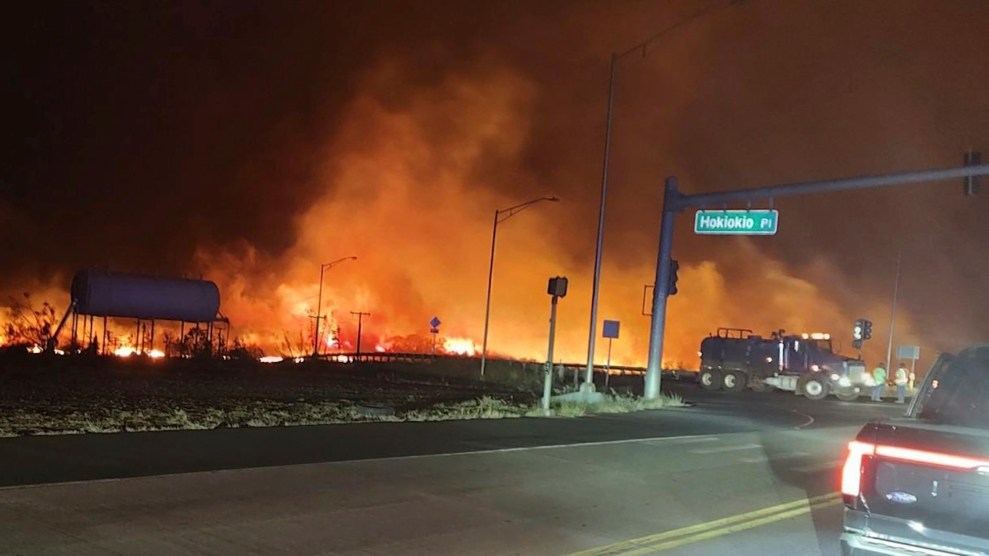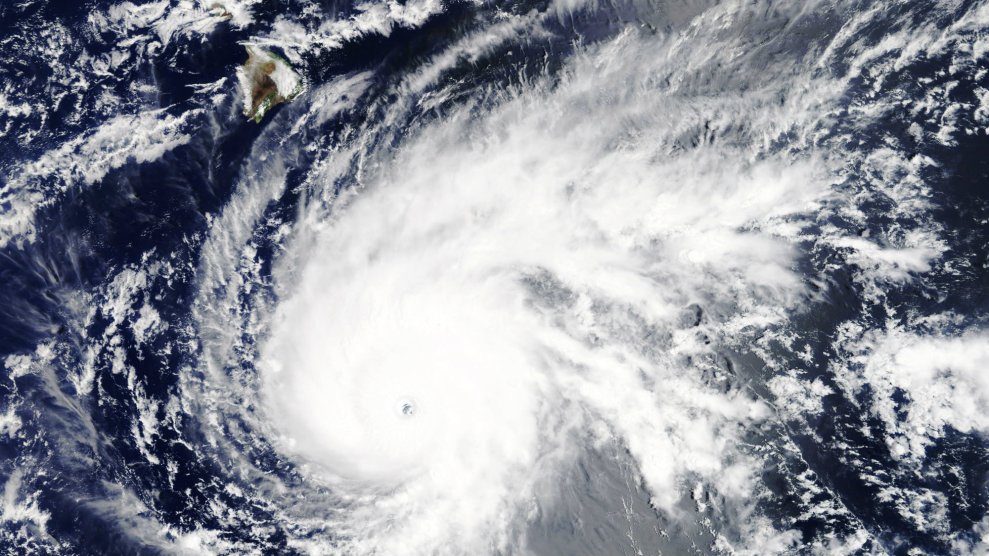
Wildfires in Hawaii fanned by strong winds burned multiple structures in areas including historic Lahaina town, forcing evacuations.Zeke Kalua/County of Maui/AP
This story was originally published by the Guardian and is reproduced here as part of the Climate Desk collaboration.
At least 55 people have died in wildfires that have ravaged the historic town of Lahaina in Hawaii, local authorities have said.
Officials warned that the death toll could rise, with the fires still burning and teams spreading out to search charred areas at first light.
“We barely made it out,” the Lahaina resident Kamuela Kawaakoa said at an evacuation shelter on Wednesday. “It was so hard to sit there and just watch my town burn to ashes and not be able to do anything,” Kawaakoa, 34, told the Associated Press.
As fire engulfed the town of 13,000 residents on Tuesday, some adults and children were driven to dive into the ocean for safety. The US Coast Guard said it rescued 14 people who jumped into the water to escape flames and smoke, including two children.
Three fires remain active on the island, in Lahaina, Pulehu, and Upcountry, Maui County said in a statement at 10:30 p.m. local time.
The Maui fire department reported “no significant changes” on the three fires, and there are no new evacuations. Nor were containment estimates were available.
County officials said firefighters have been facing “multiple flare-ups” and additional firefighters were requested from Honolulu.
The fire appears to have consumed most of Lahaina’s historic waterfront, including 271 structures and homes, and incinerated what is described as the largest banyan in the US. “These fires are absolutely devastating, and we will not know the full extent of the damage for a while. In the meantime, the highest priority is the safety of the people,” said Sen. Brian Schatz (D-HI) in a statement.
Overnight, NBC reported, 30 US Army members arrived on the island and will conduct search-and-recovery efforts Thursday morning.
Among those injured were three people with critical burns who were flown to Oahu, officials said.
The devastation is already being compared to the 2018 Camp Fire in California that killed at least 85 people, destroyed nearly 19,000 homes, businesses and other buildings, and virtually razed the town of Paradise.
Rescuers with the US Coast Guard pulled a dozen people from the ocean. Burn patients have been flown to the island of Oahu, officials said. “It was like a war zone,” Alan Barrios, a local, told Hawaii Civil Beat. “There was explosions left and right.”
President Joe Biden said he had “ordered all available federal assets on the islands to help with response.” He expressed his condolences and said that he and his wife Jill’s “prayers are with those who have seen their homes, businesses, and communities destroyed”.
Acting Hawaii governor Sylvia Luke issued an emergency proclamation on behalf of Gov. Josh Green, who was traveling, and urged tourists to stay away. “This is not a safe place to be,” she said.
On Wednesday afternoon, the US Civil Air Patrol and the Maui fire department conducted flyovers and determined at least 271 structures had been damaged or destroyed. Assessing the full extent of the damage could take weeks or months, said Mahina Martin, a spokesperson for Maui county.
People reported widespread destruction in the town, which contains several historical landmarks and was a source of pride for local people, while also popular with tourists.
Lahaina residents Kawaakoa and Iiulia Yasso told the AP about a harrowing escape under smoke-filled skies. The couple and their six-year-old son got back to their apartment after a quick dash to the supermarket for water, and only had time to grab a change of clothes and run as the bushes around them caught fire.
As the family fled, a senior center across the road erupted in flames. They called 911, but didn’t know if the people got out. As they drove away, downed utility poles and others fleeing in cars slowed their progress.
Kawaakoa grew up in the apartment building, called Lahaina Surf, where his dad and grandmother also lived. “It was so hard to sit there and just watch my town burn to ashes and not be able to do anything,” Kawaakoa said. “I was helpless.”
Baldwin Home, built in 1834-35 and the oldest house on Maui, was among the structures that burned down, a museum official said.
James Tokioka, the director of the department of business, economic development and tourism, said: “Local people have lost everything … They’ve lost their house, they’ve lost their animals.”
Hurricane Dora complicated matters for firefighters in an already dry season. Hawaii is sandwiched between high pressure to the north and a low pressure system associated with Dora, said Jeff Powell, a meteorologist in Honolulu, adding that dryness and gusts “make a dangerous fire situation so that fires that do exist can spread out of control very rapidly”.
The National Weather Service said Dora was partly to blame for wind gusts above 60 mph on Tuesday night, when the fire spread. The winds knocked out power and forced firefighting helicopters to stay grounded.
Maui County Mayor Richard Bissen Jr. said the island had “been tested like never before in our lifetime.”
“We are grieving with each other during this inconsolable time,” he said in a recorded statement. “In the days ahead, we will be stronger as a ‘kaiaulu’, or community, as we rebuild with resilience and aloha.”
The former US president Barack Obama, who was born in Hawaii, said in a statement: “It’s tough to see some of the images coming out of Hawaii—a place that’s so special to so many of us. Michelle and I are thinking of everyone who has lost a loved one, or whose life has been turned upside down.”
Update, August 11: This story has been updated to reflect the rising death toll.












